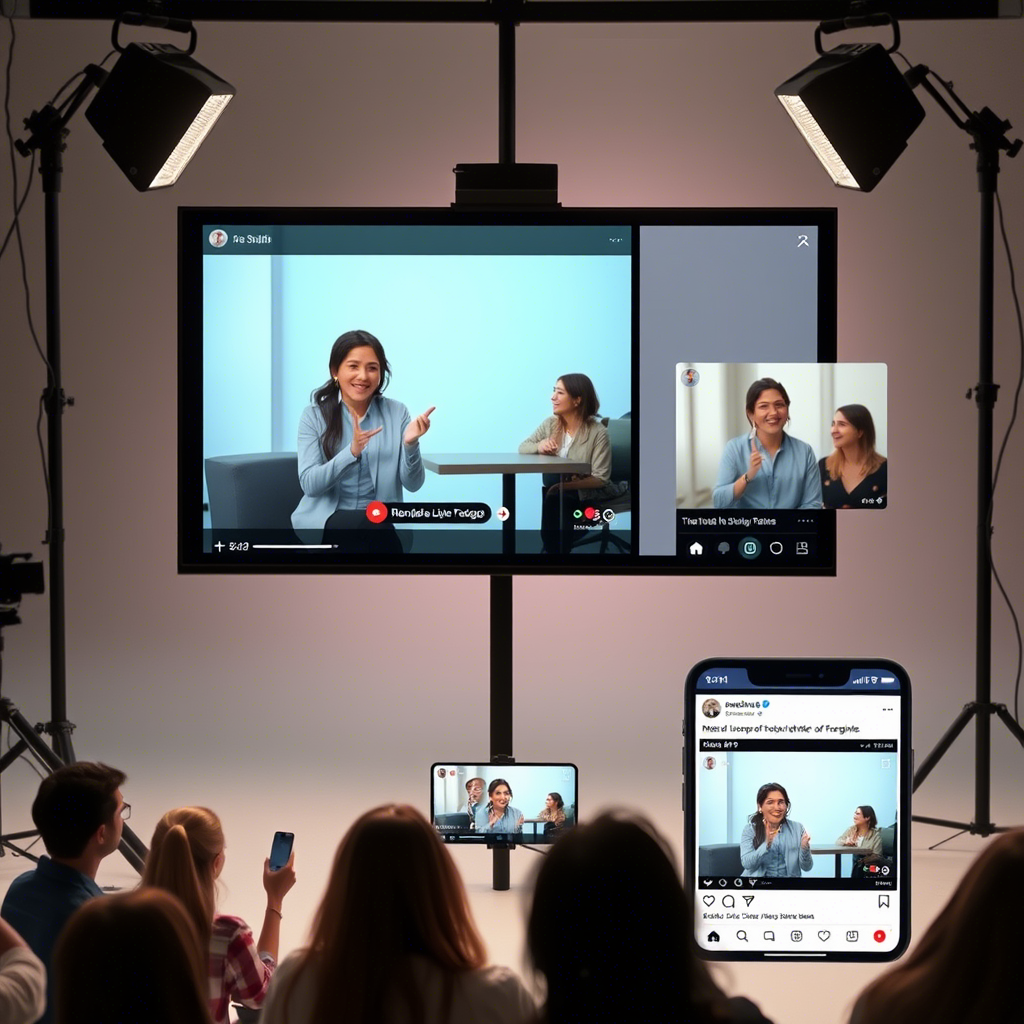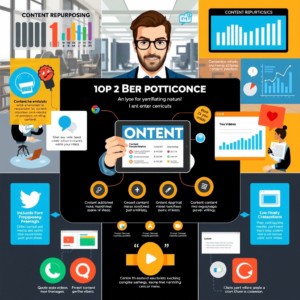Imagine connecting with your audience in real time, answering their questions instantly, and building trust without filters or edits. That’s the magic of live streaming — and in 2025, it’s more powerful than ever.
With over 2.7 billion daily active users on Facebook and 2.4 billion monthly users on Instagram , these platforms offer incredible opportunities for creators, businesses, influencers, and entrepreneurs to engage audiences authentically. Whether you’re launching a product, sharing behind-the-scenes content, or just checking in with your followers, live video is a dynamic way to grow your presence and deepen relationships.
But here’s the truth: going live isn’t just about hitting a button. It takes planning, preparation, and purpose to make your stream stand out and deliver real value.
In this article, we’ll walk through everything you need to know to host successful live streams on Instagram and Facebook , from choosing the right platform and setting up your equipment, to engaging your audience and measuring success. By the end, you’ll feel confident and ready to go live like a pro.
Let’s dive in!
1. Know Your Platforms: Instagram vs. Facebook Live
Before jumping into live streaming, it’s important to understand the unique features and benefits of each platform — especially since Instagram Live and Facebook Live serve slightly different audiences and purposes.
Instagram Live is ideal for short, spontaneous, and visually-driven content. With features like polls, questions, and countdowns, it’s perfect for creators who want to build intimacy and interact directly with followers. Plus, Instagram Stories automatically archive your live videos for 24 hours, giving your audience a second chance to catch the action.
Facebook Live , on the other hand, tends to attract an older demographic and supports longer, more in-depth broadcasts. It integrates well with Facebook Groups and Pages, making it a top choice for businesses, educators, and brands looking to host webinars, Q&A sessions, or community updates.
💡 Pro Tip: If you have a strong following on both platforms, consider cross-streaming using tools like StreamYard or Restream.io. This lets you reach both audiences at once without duplicating effort.
Regardless of which platform you choose, always tailor your content to the preferences and habits of your target audience. Knowing where your viewers hang out — and what they expect — will set the stage for a successful live session.
2. Plan Ahead: Content Strategy for Maximum Impact
Live streaming might feel spontaneous, but the most successful broadcasts are built on solid planning. Think of it like hosting a party — you wouldn’t show up empty-handed and expect everyone to stay until the end!
Start by asking yourself:
- What’s the goal of your live stream? Is it to educate, entertain, promote, or connect?
- Who is your target audience , and what do they care about?
- What kind of value will you provide during the broadcast?
Once you’ve defined your purpose, create a rough outline or script. You don’t need to be overly formal — just jot down key talking points, transitions, and any visuals or resources you plan to share.
Also, let your audience know when to tune in! Use Instagram Stories, Facebook posts, email newsletters, or even TikTok teasers to build anticipation. You can also use the Countdown Sticker on Instagram or the Event Creation Tool on Facebook to remind people when you’ll be going live.
Example Schedule:
- Day 1: Teaser post + poll to ask what they want to see
- Day 3: Reminder post + behind-the-scenes clip
- Day 4: Go live!
By treating your live stream as an event rather than a random activity, you’ll not only get more views but also more engagement and interaction.
3. Set Up for Success: Gear and Environment Tips
You don’t need a Hollywood studio to host a great live stream — but a few simple upgrades can make a big difference in how professional and polished your content appears.
Here’s what you should prioritize:
Camera
Most smartphones today have high-quality cameras, so you don’t necessarily need a DSLR unless you’re doing more advanced productions. Just make sure your phone or laptop is steady — use a tripod or phone stand.
Audio
Clear audio is non-negotiable . Built-in mics often pick up background noise or sound distant. Invest in a small lavalier mic or a USB microphone if you’re streaming from a computer.
Lighting
Good lighting ensures your face is visible and makes your stream look more engaging. Natural light works well, but if that’s not possible, a ring light or softbox setup can help eliminate shadows.
Internet Connection
A stable Wi-Fi or wired internet connection is essential to avoid buffering or dropouts. If you’re on mobile, make sure you’re in an area with strong signal strength.
Background
Keep your background clean and clutter-free. A neutral wall, bookshelf, or branded backdrop can add personality without distracting viewers.
Bonus tip: If you’re streaming from your phone, try placing it at eye level to maintain better eye contact with your audience.
Remember, the goal isn’t perfection — it’s clarity and consistency. Even a modest setup done thoughtfully can make a huge impact.
4. Engage Like a Pro: Building Real-Time Connection
The beauty of live streaming lies in its interactivity. Unlike pre-recorded videos, live streams allow you to talk with your audience, not just at them.
So how do you keep people watching and engaged?
Greet Viewers by Name
As soon as someone joins, say hello and mention their name. This personal touch makes viewers feel seen and valued.
Answer Questions in Real Time
Use the comments section to respond to questions and acknowledge feedback. For Instagram, enable the “Questions” sticker to collect questions beforehand.
Show Appreciation
Thank people for joining, commenting, or sharing your stream. Recognition encourages others to participate too.
Stay On Topic (But Be Flexible)
Stick to your planned content, but also follow the energy of the chat. If a question sparks interest, take a few minutes to explore it deeper.
Encourage Sharing
Ask viewers to tag friends who might benefit from the content or to share the stream in relevant groups.
Engagement is what turns passive viewers into active participants — and that’s how you build loyalty and community around your brand.
5. Measure, Learn, and Improve: Post-Live Strategies
Just because the stream ends doesn’t mean your job is done. In fact, the real growth happens after you go offline.
Here’s how to make the most of your live session after it’s over:
Review Analytics
Both Instagram and Facebook offer insights into how your live performed:
- Total views and peak concurrent viewers
- Average watch time
- Engagement metrics (comments, shares, reactions)
Pay attention to what worked and what didn’t. Did people drop off after the first few minutes? Did a particular topic spark more interaction?
Repurpose Your Content
Turn your live video into shorter clips, reels, or blog posts. Tools like Descript or CapCut can help you edit and extract highlights.
You can also upload the full replay to YouTube or your website for SEO value and long-term visibility.
Follow Up with Your Audience
Send a thank-you message via DM or social media. Ask for feedback or suggestions for future topics. This builds goodwill and gives you ideas for your next stream.
Reflect and Refine
Ask yourself:
- What went well?
- What could I improve?
- What did my audience seem to enjoy most?
Each live stream is a learning opportunity. The more you practice, the more natural and effective your broadcasts become.
Conclusion: Make Live Streaming Part of Your Digital Strategy
Hosting successful live streams on Instagram and Facebook isn’t about being perfect — it’s about being present, prepared, and personable.
From understanding your platforms and planning your content, to optimizing your setup and engaging your audience, every step plays a role in creating meaningful connections and growing your influence.
And remember: live streaming is one of the most authentic ways to communicate online. It allows you to show up as yourself, share your knowledge, and build trust in real time.
So whether you’re a small business owner, a content creator, or simply someone who wants to connect more deeply with your audience, now is the perfect time to start going live.
Ready to hit that “Go Live” button?
What’s stopping you from starting your next live stream? Share your thoughts below — or better yet, schedule your next live session and tell us about it!
Frequently Asked Questions (FAQ)
Q: Can I go live on Instagram and Facebook at the same time?
Yes! You can cross-stream using third-party tools like StreamYard, Restream.io, or Ecamm Live. These services allow you to broadcast to multiple platforms simultaneously.
Q: How long should a live stream be?
There’s no one-size-fits-all answer, but aim for 15–45 minutes depending on your content. Shorter streams work best for quick tips or updates, while longer sessions suit interviews or tutorials.
Q: Do live videos show up in feeds?
Yes, especially if your followers are active when you go live. Facebook prioritizes live content in newsfeeds, and Instagram promotes live videos to your followers’ Explore page.
Q: Should I save my live videos?
Absolutely. Both platforms automatically save your live streams to your Story (for 24 hours) and allow you to save them to your profile afterward. Saving helps you repurpose content and track performance.
Q: How do I handle technical issues during a live stream?
Stay calm and communicate with your audience. Let them know there’s a minor issue and reassure them you’ll be back shortly. Always test your setup before going live to minimize disruptions.
Final Thoughts: Keep Showing Up and Growing
Live streaming is more than just a trend — it’s a powerful tool for communication, education, and connection. As algorithms continue to favor real-time content, those who embrace live video will have a distinct advantage in reaching and engaging their audience.
Now that you’ve got the roadmap, it’s time to put these strategies into action. Start small, stay consistent, and keep improving. Over time, you’ll not only master the art of live streaming — you’ll build a loyal community that looks forward to hearing from you.
And hey — don’t forget to have fun along the way. After all, live streaming is about being real, being human, and being heard.
Ready to Level Up Your Live Game?
Leave a comment below with your favorite live streaming tip or your biggest challenge — and let’s learn together!
Don’t forget to share this guide with anyone who needs help mastering Instagram and Facebook Live.




